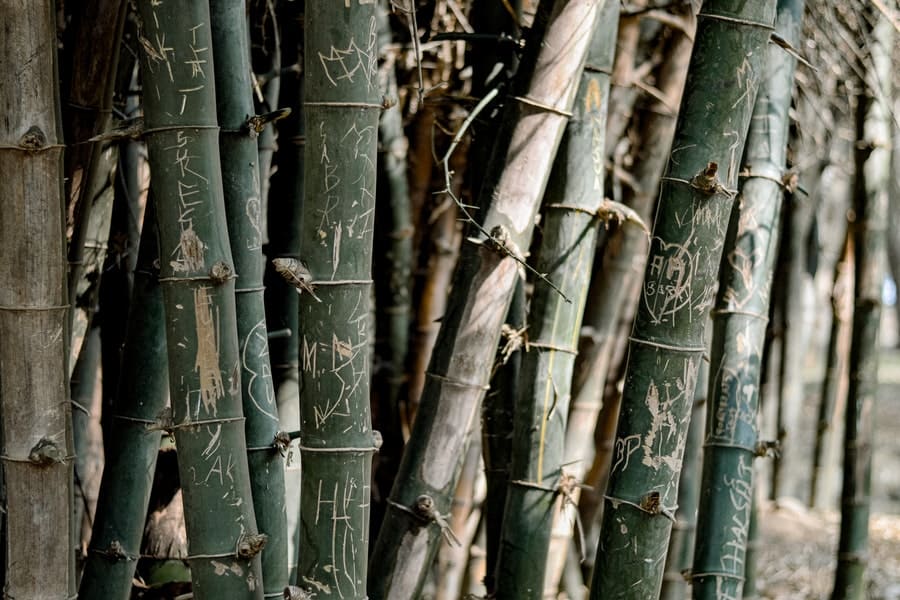Bamboo is an impressive and useful plant that can be grown almost anywhere with the right climate and soil. There are numerous species of bamboo, each with its own unique characteristics, growth rate, and planting needs. Cultivating bamboo from cuttings is an excellent way to propagate new plants so you have a constant supply of them. You can find cuttings at your local nursery or garden center during spring and summer when plant propagation is most common. Cuttings are essentially small pieces of another plant that you can grow into a whole new plant. Once you take your cutting, the hard part comes from getting it to grow into a healthy new plant while avoiding as many problems as possible. Bamboo cuttings are relatively easy to take and grow if you follow these steps appropriately.
How To Grow Bamboo From Cuttings
Collecting Bamboo Cuttings
To begin, you will need to find a healthy bamboo plant with branches that bend easily. This is an important factor as the bamboo cutting will be used to grow new shoots from the shoot nodes. The shoot nodes are where the branches or stems split off from the main trunk of the plant. You also want to make sure that your bamboo cutting is taken from a young plant that has not yet flowered because flowering signals maturity and new growth becomes more difficult once a bamboo plant flowers.
Take Your Cutting
The process of taking a cutting is relatively simple, but it must be done correctly in order for your cutting to grow into a healthy new plant. First, cut your branch as close to its source on the main stem of your bamboo plant as possible without damaging any nearby growth or making it bleed profusely. Next, remove all leaves from your branch except for three leaves at the very end and one leaf about one inch above where you removed all other leaves. These leaves will help transport nutrients and moisture throughout your new plant during its initial stages of growth until it can develop its own roots and find water on its own.
Prepare Your Bamboo Cutting for Growth
After you have taken a good strong cutting from your bamboo plant, you’ll need to prepare it for growth by removing some of its bottom leaves so that it can receive proper light and air circulation while growing roots before being planted in soil or an artificial growing medium such as coconut fiber.
Plant Your Bamboo Cutting
After you have prepared your cutting, you can plant it in soil or an artificial growing medium. If you decide to plant it in soil, simply dig a small hole about two inches deep and place your bamboo cutting inside of the hole so that the base of the stem is covered by soil while the top of your cutting is exposed to light and air circulation. If you choose to use an artificial growing medium such as coconut fiber, simply place your bamboo cutting into a pot or container filled with coconut fiber or another suitable growing medium with the base of its stem buried at least one inch beneath the surface while its top is exposed to light and air circulation.
Water Your Bamboo Cutting
It is very important that you water your bamboo cutting regularly and properly. If you are using coconut fiber or another artificial growing medium, simply pour water into your container until it is completely saturated. Be careful not to overwater your cutting as this can cause the soil to become too wet which will inhibit the proper growth of your bamboo cutting. If you are planting in soil, you can water your plant by simply watering the ground around its base with a garden hose or watering can until it is evenly moist but not overly wet. It may be necessary for you to check the moisture levels of the soil every day or two in order to keep it properly watered during its initial stages of growth before developing its own roots and becoming more independent from its parent plant. Once your bamboo cutting has developed its own roots and become more independent from its parent plant, it will no longer need daily watering and can be watered about once every two or three days depending on how much rain falls in your area during this time period.
Where To Take Cuttings From
-
Select a bamboo plant that has been growing for at least three years. Younger plants have not had time to develop the proper roots which can lead to problems with the new cutting.
-
Choose a section of the bamboo plant that is healthy, but not overcrowded or too dense.
-
If your plant is in a pot, remove it and gently dig around it to loosen the roots before taking your cutting.
-
Use a sharp knife or pruning shears to cut off a section of bamboo that has at least one node (the small bump where you see new growth) on it. Cut the section just below this node, making sure not to damage any of the other nodes on the rest of the plant.
-
If your bamboo is in an area where there is direct sunlight, make sure to put some sort of shade over it so that it does not dry out after you take your cutting. This will keep moisture in and help prevent wilting until you get your new plant into its own container with soil.
-
Place your cutting into its own pot filled with well-draining soil, such as cactus mix or sand. Water well and place somewhere that receives plenty of sun but also protection from strong winds and direct sunlight so that it doesn’t dry out immediately after planting. Bamboo-like warm temperatures between 60-75 degrees Fahrenheit (15-24 degrees Celsius).
-
Keep cuttings moist by watering regularly, especially during their first few months of growth.
-
After a few weeks, you should see new leaves beginning to grow from the node you took your cutting from. As your bamboo grows, slowly move it into its own pot until it is ready for planting outside.
The Best Time To Take Bamboo Cuttings
1. The first thing you need to decide is when you want your new bamboo plant to grow. You can take cuttings at any time of year, however, some seasons are better than others. The most successful bamboo cuttings are taken during the spring when the sap is flowing in the bamboo plants. Spring growth is also more vigorous than summer and fall growth, so your new plant will be healthier and more likely to thrive if it was taken during this period.
2. Once you have decided when you want your bamboo plant to grow, you have to choose which species of bamboo you want to propagate. Bamboo species that are best for propagation from cuttings include Phyllostachys aurea, Phyllostachys bambusoides, and Phyllostachys nigra. These three species are fast-growing and produce roots quickly with little effort on your part once they have been taken from the parent plant.
3. Choose a healthy parent plant for your cutting that has an abundance of green leaves, dark green or brown culms (stems), and small branches growing out of it. The best time to take a cutting is when the bamboo plant is actively growing and producing new shoots, not when it’s dormant or dying back in the late fall or winter months. Cuttings should be taken from large shoots that are approximately 2 inches in diameter with at least one node.
4. To take a cutting, use clean, sharp pruning shears to cut a section of the parent plant that is approximately 3 inches in length. The cutting should have at least one node and ideally two nodes. The nodes are the small bumps that appear along the length of the stem and are where leaves grow out. Once you have your cutting, place it into a container filled with dampened sphagnum moss or peat moss. It’s important to keep your bamboo cutting moist at all times, but never allow it to sit in water for long periods of time or it will die.
5. Place your cutting in a warm, sunny location and keep it watered regularly until new shoots begin to emerge from the ground. You can use a rooting hormone on your bamboo cuttings if you want, but they can also be propagated without any special treatment other than proper watering and sunlight.
How To Take A Bamboo Cutting
1. Take a cutting that is at least 6 inches long.
2. Make sure it is well-rooted, with a healthy green color to the leaves and stems.
3. Cut the cutting at an angle with a clean, sharp blade.
4. Dip the cut portion of the bamboo in rooting hormone powder and place it in a pot filled with soil that has been mixed with compost or peat moss.
5. Cover the container with plastic to help retain moisture and put it somewhere warm, but not hot or cold.
6. Keep an eye on your new bamboo plant for about two weeks as it starts to root and adjust to its new environment.
7. After about two weeks, remove the plastic cover and watch your bamboo grow!
Conclusion
Bamboo cuttings are the best way to propagate new bamboo plants and have a constant supply of bamboo around your yard and garden. There are numerous species of bamboo, each with its own unique characteristics, growth rate, and planting needs. Cultivating bamboo from cuttings is an excellent way to start new bamboo plants and you can find cuttings at your local nursery or garden center during spring and summer when plant propagation is most common. After reading this guide, you will understand how to take bamboo cuttings and care for them until they root and become a full-grown bamboo plants. Bamboo is an excellent and useful plant that can be grown almost anywhere with the right climate and soil.








